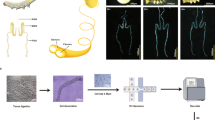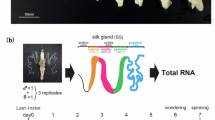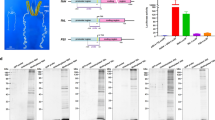Abstract
Sericulture has been greatly advanced by applying hybrid breeding techniques to the domesticated silkworm, Bombyx mori, but has reached a plateau during the last decades. For the first time, we report improved silk yield in a GAL4/UAS transgenic silkworm. Overexpression of the Ras1CA oncogene specifically in the posterior silk gland improved fibroin production and silk yield by 60%, while increasing food consumption by only 20%. Ras activation by Ras1CA overexpression in the posterior silk gland enhanced phosphorylation levels of Ras downstream effector proteins, up-regulated fibroin mRNA levels, increased total DNA content, and stimulated endoreplication. Moreover, Ras1 activation increased cell and nuclei sizes, enriched subcellular organelles related to protein synthesis, and stimulated ribosome biogenesis for mRNA translation. We conclude that Ras1 activation increases cell size and protein synthesis in the posterior silk gland, leading to silk yield improvement.
Similar content being viewed by others
Log in or create a free account to read this content
Gain free access to this article, as well as selected content from this journal and more on nature.com
or
References
Ribaut JM, de Vicente MC, Delannay X . Molecular breeding in developing countries: challenges and perspectives. Curr Opin Plant Biol 2010; 13:1–6.
Yoshiaki M, Hirovvo I, Kiyoshi S, Keiko I, Yoichi M, Shuji H . Studies on the protein synthesis in silkglands V. The relation of ribosomes to endoplasmic reticulum during fibroin synthesis. J Biochemi 1964; 55:623–628.
Tashiro Y, Morimoto T, Matsuura S, Nagata S . Studies on the posterior silk gland of the silkworm Bombyx mori I. Growth of posterior silk gland cells and biosynthesis of fibroin during the fifth larval instar. J Cell Biol 1968; 38:574–588.
Shigematsu H, Kurata K, Takeshita, H . Nucleic acids accumulation of silk gland of Bombyx mori in relation to silk protein. Comp Biochem Physiol B 1978; 61:237–242.
Blaes N, Couble P, Prudhomme JC . The programming of silk-gland development in Bombyx mori. I. Effects of experimental starvation on growth, silk production, and autolysis during the fifth larval instar studied by electron microscopy. Cell Tissue Res 1980; 213:311–324.
Akai HII . The structure and ultrastructure of the silk gland. Experientia 1983; 39:443–449.
Karnoub AE, Weinberg RA . Ras oncogenes: split personalities. Nat Rev Mol Cell Biol 2008; 9:517–531.
Caldwell, P.E ., Walkiewicz, M ., Stern, M . Ras activity in the Drosophila prothoracic gland regulates body size and developmental rate via ecdysone release. Curr Biol 2005; 15:1785–1795.
Ogura T, Tan A, Tsubota T, Nakakura T, Shiotsuki T . Identification and expression analysis of ras gene in silkworm, Bombyx mori. PLoS One 2009; 4:e8030.
Moriya K, Tsubota T, Ishibashi N, et al. Bombyx mori Ras proteins BmRas1, BmRas2 and BmRas3 are neither farnesylated nor palmitoylated but are geranylgeranylated. Insect Mol Biol 2010; 19:291–301.
Imamura M, Nakai J, Inoue S, Quan GX, Kanda T, Tamura T . Targeted gene expression using the GAL4/UAS system in the silkworm Bombyx mori. Genetics 2003; 165:1329–1340.
Tan AJ, Tanaka H, Tamura T, Shiotsuki T . Precocious metamorphosis in transgenic silkworms overexpressing juvenile hormone esterase. Proc Natl Acad Sci USA 2005; 102:11751–11756.
Oldham S, Hafen E . Insulin/IGF and target of rapamycin signaling: a TOR de force in growth control. Trends Cell Biol 2003; 13:79–85.
Tamura T, Thibert C, Royer C, et al. Germline transformation of the silkworm Bombyx mori L. using a piggyBac transposon-derived vector. Nat Biotechnol 2000; 18: 81–84.
Duffy JB . GAL4 system in Drosophila: a fly geneticist's Swiss army knife. Genesis 2002; 34:1–15.
Liu Y, Zhou S, Ma L, et al. Transcriptional regulation of the insulin signaling pathway genes by starvation and 20-hydroxyecdysone in the Bombyx fat body. J Insect Physiol 2010; 56:1436–1444.
Xia Q, Guo Y, Zhang Z, et al. Complete resequencing of 40 genomes reveals domestication events and genes in silkworm (Bombyx). Science 2009; 326:433–436.
Xia Q, Cheng D, Duan J, et al. Microarray-based gene expression profiles in multiple tissues of the domesticated silkworm, Bombyx mori. Genome Biol 2007; 8:R162.
Edgar BA, Orr-Weaver TL . Endoreplication cell cycles: more for less. Cell 2001; 105:297–306.
Chang F, Steelman LS, Lee JT, et al. Signal transduction mediated by the Ras/Raf/MEK/ERK pathway from cytokine receptors to transcription factors: potential targeting for therapeutic intervention. Leukemia 2003; 17:1263–1293.
Adhikary S, Eilers M . Transcriptional regulation and transformation by Myc proteins. Nat Rev Mol Cell Biol 2005; 6:635–645.
Britton JS, Edgar BA . Environmental control of the cell cycle in Drosophila: nutrition activates mitotic and endoreplicative cells by distinct mechanisms. Development 1998; 125:2149–2158.
Frei C, Edgar BA . Drosophila cyclin D/Cdk4 requires Hif-1 prolyl hydroxylase to drive cell growth. Dev Cell 2004; 6:241–251.
Brogiolo W, Stocker H, Ikeya T, Rintelen F, Fernandez R, Hafen E . An evolutionarily conserved function of the Drosophila insulin receptor and insulin-like peptides in growth control. Curr Biol 2001; 11:213–221.
Wullschleger S, Loewith R, Hall MN . TOR signaling in growth and metabolism. Cell 2006; 124:471–484.
Bhaskar PT, Hay N . The two TORCs and Akt. Dev Cell 2007; 12:487–502.
Zhou S, Zhou Q, Liu Y, et al. Two Tor genes in the silkworm, Bombyx mori. Insect Mo Biol 2010; 19:727–735.
Kikuchi Y, Mori K, Suzuki S, Yamaguchi K, Mizuno S . Structure of the Bombyx mori fibroin light-chain-encoding gene: upstream sequence elements common to the light and heavy chain. Gene 1992; 110:151–158.
Brand AH, Perrimon N . Targeted gene expression as a means of altering cell fates and generating dominant phenotypes. Development 1993; 118:401–415.
Dai H, Ma L, Wang J, Jiang RJ, Wang Z, Fei J . Knockdown of ecdysis-triggering hormone gene with a binary UAS/GAL4 RNA interference system leads to lethal ecdysis deficiency in silkworm. Acta Biochim Biophys Sin 2008; 40:790–795.
Zhao A, Zhao T, Zhang Y, et al. New and highly efficient expression systems for expressing selectively foreign protein in the silk glands of transgenic silkworm. Transgenic Res 2010; 19:29–44.
Hediger M, Niessen M, Wimmer EA, Dübendorfer A, Bopp D . Genetic transformation of the housefly Musca domestica with the lepidopteran derived transposon piggyBac. Insect Mol Biol 2001; 10:113–119.
Tian L, Guo E, Dian Y, et al. Genome wide regulation of innate immunity by juvenile hormone and 20-hydroxyecdysone in the Bombyx fat body. BMC Genomics 2010; 11:549.
Li S . Identification of iron-loaded ferritin as an essential mitogen for cell proliferation and postembryonic development in Drosophila. Cell Res 2010; 20:1148–1157.
Acknowledgements
The transgenic silkworm Fil-GAL4/UAS-Ras1CA has been protected by the Chinese Intellectual Property Deputy under the patent 201010118072.8. This study was supported by 2007AA10Z155, KSCX-YW-N-009, 30770271, 10JC1416700, 2007CB947100, 2006CB943902, 30870299, 2006AA10A119, and Hundred Talent Project to SL as well as 2005CB121000 to QX. We are grateful to Drs Jian Fei, Zhugang Wang, and Hongjiu Dai in Shanghai Research Center for Model Organisms for their support of the initial transgenic silkworm studies. We thank Dr David Stanley for improving this manuscript.
Author information
Authors and Affiliations
Corresponding authors
Additional information
( Supplementary information is linked to the online version of the paper on the Cell Research website.)
Supplementary information
Supplementary information, Figure S1
MAPK phosphorylation level correlates and slightly precedes the growth rate of posterior silk gland. (PDF 64 kb)
Supplementary information, Figure S2
Inhibition of PI3K110 activity reduces silk gland size. (PDF 428 kb)
Supplementary information, Figure S3
Increasing posterior silk gland size by Ras1CA overexpression greatly improves silk yield. (PDF 108 kb)
Supplementary information, Figure S4
BrdU labeling in the posterior silk gland from [D(+)E(+)] (A') is stronger than those in the controls [D(−)E(−)] (A). (PDF 76 kb)
Supplementary information, Figure S5
Ras1 activation increases the posterior silk gland size observed under optical microscopy. (PDF 22 kb)
Supplementary information, Figure S6
A proposed model shows that increasing posterior silk gland size and stimulating fibroin protein synthesis by Ras1CA overexpression in the transgenic silkworm Fil-GAL4/UAS-Ras1CA. (PDF 91 kb)
Supplementary information, Table S1
All primers used in this paper (PDF 7 kb)
Rights and permissions
About this article
Cite this article
Ma, L., Xu, H., Zhu, J. et al. Ras1CA overexpression in the posterior silk gland improves silk yield. Cell Res 21, 934–943 (2011). https://doi.org/10.1038/cr.2011.36
Received:
Revised:
Accepted:
Published:
Issue date:
DOI: https://doi.org/10.1038/cr.2011.36
Keywords
This article is cited by
-
Performance of some newly produced multivoltine strains of Bombyx mori (Linnaeus) for commercially vibrant qualitative and quantitative traits
International Journal of Tropical Insect Science (2021)
-
A transcriptome atlas of silkworm silk glands revealed by PacBio single-molecule long-read sequencing
Molecular Genetics and Genomics (2020)
-
Insights into the regulatory characteristics of silkworm fibroin gene promoters using a modified Gal4/UAS system
Transgenic Research (2019)
-
New insight into the mechanism underlying the silk gland biological process by knocking out fibroin heavy chain in the silkworm
BMC Genomics (2018)
-
Extraordinary Mechanical Properties of Composite Silk Through Hereditable Transgenic Silkworm Expressing Recombinant Major Ampullate Spidroin
Scientific Reports (2018)



